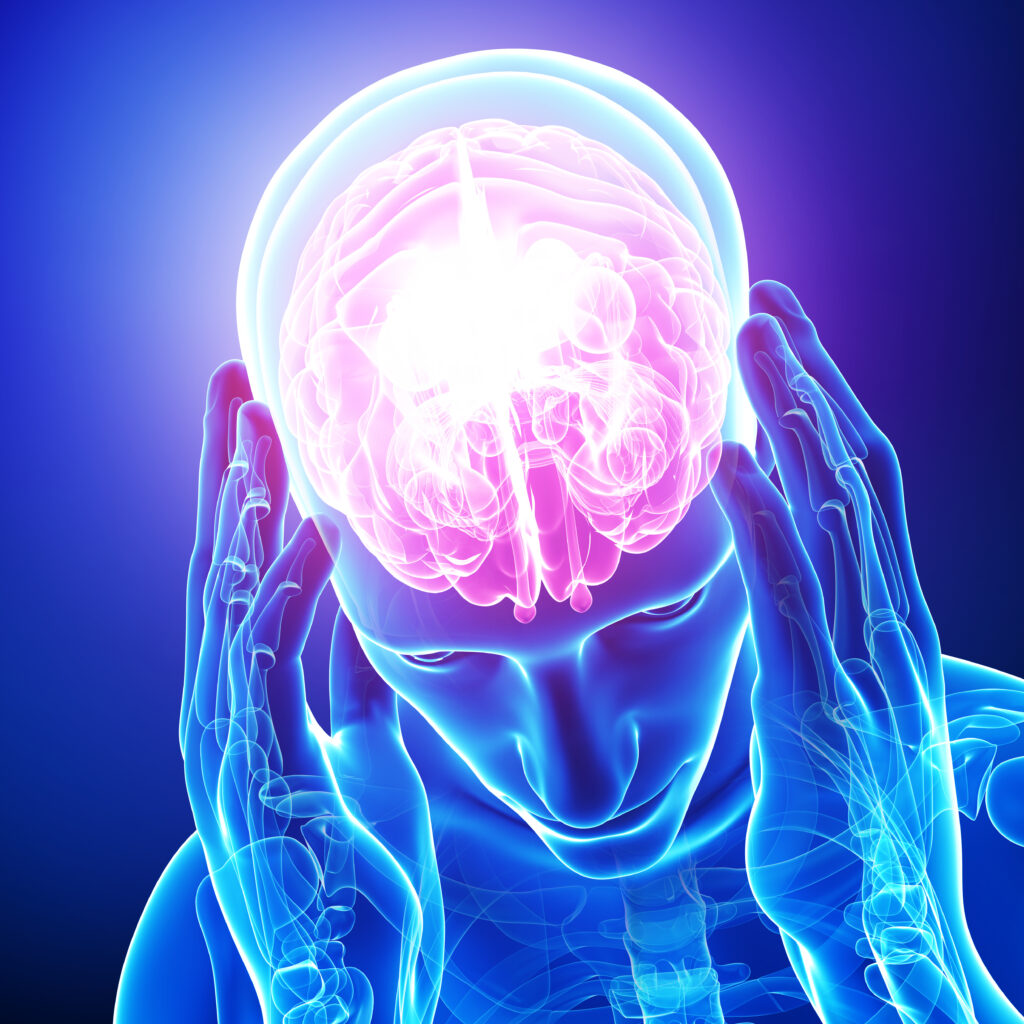The article “The Neurometabolic Cascade of Concussion” explores the brain’s response to a concussion, explaining the complex chain of events that occur at the cellular level. This article is a compilation of over 100 articles from both basic science and clinical medical literature selected for relevance to concussive brain injury, post-injury pathophysiology, and recovery of function.
Article High Level Summary;
After a concussion, the brain enters a state of dysfunction, often compared to an energy crisis. This cascade begins with a sudden release of chemicals in the brain, leading to an imbalance of ions (charged particles) inside and outside of brain cells. This imbalance forces cells to work harder to restore normal conditions, using up much of their energy supply.
At the same time, blood flow to the brain decreases, meaning the brain isn’t receiving enough oxygen and nutrients to function or repair itself properly. This mismatch between the energy demand and the limited supply puts the brain under stress. This stress can lead to cognitive and physical symptoms commonly associated with concussions, such as headaches, dizziness, and confusion.
The article highlights that this process can take days or even weeks to resolve, depending on the severity of the concussion and the individual’s health. It emphasizes the importance of rest and gradual return to activities to allow the brain to heal and avoid further injury during this vulnerable period.
For those of you who want to understand the underpinnings of concussion with more detail, see my summary below. If you want the quick and dirty summary of what to do after concussion, skip the 51 point summary and see my recommendations post concussion.
1) “Concussion is defined as any transient neurologic dysfunction resulting from a biomechanical force.”
2) “Loss of consciousness is a clinical hallmark of concussion but is not required to make the diagnosis.”
3) Typical symptoms of concussion include confusion, disorientation, unsteadiness, dizziness, headache, and visual disturbances.
4) The primary elements of the pathophysiologic cascade following concussive brain injury are:
• Abrupt massive neuronal depolarization
• The massive release of excitatory neurotransmitters [glutamate, aspartate]
• Massive ionic shifts [Calcium (Ca++) influx, Potassium efflux (K+)]
• Changes in glucose metabolism
• Reduced cerebral blood flow
• Impaired axonal function [Ca++ influx, swelling, axonal death]
5) “Immediately after biomechanical injury to the brain, abrupt, indiscriminate release of neurotransmitters [glutamate, aspartate] and unchecked ionic fluxes [K+ efflux, Ca++ influx] occur.”
6) “The binding of excitatory transmitters, such as glutamate, to the N-methyl-D-aspartate (NMDA) receptor leads to further neuronal depolarization with efflux of potassium and influx of calcium.” These ionic shifts cause substantial changes in neuronal physiology.
7) In an effort to restore the neuronal membrane potential, the sodium-potassium (Na-K) pump works overtime. The Na-K pump requires increased amounts of adenosine triphosphate (ATP), triggering a dramatic jump in glucose metabolism. “This ‘hypermetabolism’ occurs in the setting of diminished cerebral blood flow, and the disparity between glucose supply and demand triggers a cellular energy crisis.”
8) The increase in calcium also impairs mitochondrial oxidative metabolism, worsening the energy crisis.
9) Cytochrome oxidase is a measure of oxidative metabolism, and is reduced for 10 days post-injury. [Important for low-level-laser therapy applications]
10) Other important components of posttraumatic cerebral pathophysiology include the “generation of lactic acid, decreased intracellular magnesium, free radical production, inflammatory responses, and altered neurotransmission.” [This argues for the rationale of supplementing with Mg++, increasing antioxidants, and increasing EPA (anti inflammatory) omega-3 fatty acids]
11) Immediately after biomechanical injury to the brain, there is massive nonspecific depolarization, leading to a massive release of the excitatory amino acid (EAA) glutamate. [Reducing consumption of glutamate (MSG) and aspartame (half of aspartate artificial sweetener) could improve clinical outcomes]
12) The massive excitation is then followed by a wave of neuronal suppression termed spreading depression. Early loss of consciousness, amnesia, or other cognitive dysfunction may be manifestations of this posttraumatic spreading depression.
13) “In an effort to restore ionic homeostasis, energy-requiring membrane pumps are activated and trigger an increase in glucose use.” This abrupt increase in energy requirements is met by an increase in glycolysis [enzymatically increasing the conversion of glucose into pyruvate]. Accelerated glycolysis increases lactate production, resulting in lactate accumulation.
14) “Elevated lactate levels can result in neuronal dysfunction by inducing acidosis, membrane damage, altered blood brain barrier permeability, and cerebral edema.”
15) Traumatic brain injury may reduce cerebral blood flow (CBF) by 50% of normal. [This is a very important element that is often missed in traditional medical/physio post concussion management]
16) The posttraumatic decrease in CBF, in a setting of increased glucose use (hyperglycolysis), creates a mismatch in supply and demand causing a damaging energy crisis.
17) Activated NMDA receptors form a pore through which calcium (Ca++) enters the cell, and neuronal Ca++ accumulation occurs within hours of concussion.
18) “Intra-axonal calcium flux has been shown to disrupt neurofilaments and microtubules, impairing posttraumatic neural connectivity.” [Mg++ is neuroprotective]
19) “Unchecked calcium accumulation can directly activate pathways leading to cell death.” [Magnesium (Mg++) is neuroprotective]
20) Ca++ channel blockers “significantly reduce post-concussive Ca++ accumulation.” [Mg++ is Mother-Nature’s Ca++ channel blocker; Mg++ is neuroprotective]
21) Cannabinoids have been shown to block the NMDA receptor with an associated reduction in post-TBI Ca++ accumulation.
22) Excess intracellular Ca++ impairs mitochondrial function, resulting in impaired oxidative metabolism and energy failure. The Ca++ influx “corresponds to neuronal death.”
23) Increased axonal Ca++ levels lead to microtubule breakdown.
24) Intracellular Ca++ may trigger cell death by leading to free radical overproduction and activation of apoptotic genetic signals. [This serves the rationale for increasing antioxidants]
25) Intracellular Mg++ levels are immediately reduced after TBI and remain low for up to 4 days.
26) Reduction in Mg++ correlates with post-injury neurologic deficits, and posttreatment to restore Mg++ levels results in improved protection and recovery.
27) Decreased Mg++ levels leads to neuronal dysfunction.
28) Mg++ is necessary for maintaining the cellular membrane potential and initiating protein synthesis.
29) Low levels of Mg++ leads to greater influx of Ca++ and its deleterious intracellular consequences.
30) Injured cells may be capable of recovering after an initial injury, but a second concussion during this energy crisis can lead to cell death.
31) “Athletic trainers and athletes feel significant pressure to return athletes to practice and play as soon as possible after injury.”
32) “Repeated injury within a particular time frame can lead to a much larger anatomical or behavioral impairment than 2 isolated injuries.”
33) “The resulting energy crisis [from the first impact] is a likely mechanism for post-concussive vulnerability, making the brain less able to respond adequately to a second injury and potentially leading to longer-lasting deficits.”
34) During rehabilitation, it is possible to over-stimulate the injured brain and this excessive activation can lead to longer-lasting deficits. [Do not exceed the neuron’s metabolic threshold]
36) “Long-term deficits in memory and cognition in a setting of minimal anatomic change are often seen after concussion.” These result from post-concussive alterations in glutamatergic (NMDA), adrenergic, and cholinergic systems. [This is why the use of “anti-cholinergic” drugs is problematic, and the consumption of acetylcholine enhancing supplements is encouraged]
37) Inhibitory neurotransmission is altered after TBI. The loss of gamma amino butyric acid (GABA) can predispose the traumatized brain to subsequent development of seizures.
38) Long-term follow-up studies demonstrate persistent neurocognitive deficits after pediatric TBI. [Here is another important aspect that is missing in our follow up in traditional medical/physio post-concussion management]
39) “Steps in the physiologic cascade involve increased intracellular calcium, mitochondrial dysfunction, impaired oxidative metabolism, decreased glycolysis, diminished CBF, axonal disconnection, neurotransmitter disturbances, and delayed cell death.”
40) “It is during this post-injury period, when cellular metabolism is already stretched to its limits, that the cell is more vulnerable to further insults.”
41) Increased intracellular Ca++ accumulation “impairs mitochondrial metabolism at the time when the cell can least tolerate a reduction in ATP production.”
42) Alterations in NMDA receptor composition can persist, and a second injury in this period can lead to further impairment of excitatory neurotransmission with a greater degree of cognitive dysfunction.
43) Post-TBI changes in inhibitory neurotransmission can “leave neurons more susceptible to massive depolarization and excitatory amino acid (EAAs) [glutamate/aspartate] release after a recurrent concussion.”
44) Posttraumatic derangements in glucose metabolism persist for 2 to 4 weeks after injury.
45) Secondary axotomy (ongoing axonal damage and death) occurs in human brain tissue weeks after trauma.
46) “Cerebral concussion is followed by a complex cascade of ionic, metabolic, and physiologic events.”
47) “The earliest changes are an indiscriminate release of EAAs and a massive efflux of K+, triggering a brief period of hyperglycolysis.”
48) This is followed by more persistent Ca++ influx, mitochondrial dysfunction with decreased oxidative metabolism, diminished cerebral glucose metabolism, reduced CBF, and axonal injury.
49) “Late events in the cascade include recovery of glucose metabolism and CBF, delayed cell death, chronic alterations in neurotransmission, and axonal disconnection. Clinical signs and symptoms of impaired coordination, attention, memory, and cognition are manifestations of underlying neuronal dysfunction, most likely due to some of the processes described above.”
50) “Traumatic injury to the developing brain may lead to long-lasting changes in cognitive potential, perhaps even with little evidence of an initial deficit.”
51) “Children and adolescents who sustain a concussive brain injury should be closely monitored over time for the later appearance of neurobehavioral abnormalities.”
Dr. J’s post concussion protocol for 100+Living
1) Improve cerebral blood flow: This has been directly linked to specific upper cervical spinal adjustments, either by hand or with a well researched mechanical adjusting instrument. Most of the positive outcome research with instrument adjusting has been with the Impulse adjusting instrument from Neuromechaical Innovations, some with the Arthrostim adjusting instrument. [not with the activator, proadjustor or other devices marketed as adjusting instruments]
2) Avoid dietary consumption of excitatory amino acids glutamate and aspartate. Most people are aware of avoiding MSG but just in case you’re unaware, MSG is a neurotoxin.
3) Increase ATP production through supporting mitochondrial health: Cervical Spine Chiropractic Adjustment, Trans-cranial Low-Level Laser Therapy, Consume Medium-Chain Saturated Triglycerides (coconut oil), Supplement with Acetyl-l-Carnitine + Alpha-Lipoic Acid
4) Take supplemental magnesium, about 900 mg/day.
5) Take exogenous anti-oxidants (quality multiple vitamin-mineral supplement but watch copper amounts)
6) Increase endogenous anti-oxidants, especially glutathione [undenatured whey protein, NAC, Alpha-Lipoic Acid, etc.]
7) Manage Post-Concussive Syndrome: Omega-3s EPA+DHA [15 grams a day for the first 15 days and 5 grams thereafter], Curcumin [300-500mg/day], Magnesium [500mg, glycinate or citrate/day], Vitamin D3 [5000-7000IU/day], Resveratrol, Green Tea (EGCGs)
8) Consume Acetylcholine enhancing supplements
9) Creatine daily, 5mg/day
10) DO NOT have a second brain injury, especially within the next 30-60 days.


